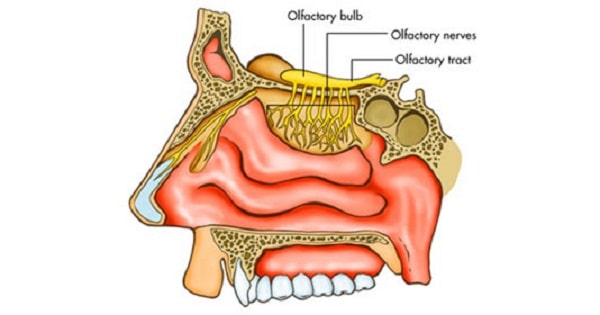OLFACTION
Where are the Odour receptors located?
| A |
Neurons of olfactory epithelium |
|
| B |
Olfactory tract |
|
| C |
Amygdala |
|
| D |
Olfactory bulbs |
Where are the Odour receptors located?
| A |
Neurons of olfactory epithelium |
|
| B |
Olfactory tract |
|
| C |
Amygdala |
|
| D |
Olfactory bulbs |
Odour receptors cells are located in the mucosa high up in the nose (olfactory epithelium).
The central processes of the olfactory receptor cells form the olfactory nerve. Olfactory nerves cross cribriform plate and end on the mitral cells of olfactory bulbs.
The axons of mitral cells form the olfactory tract and they end upon pre piriform cortex and amygdale.
Mitral and periglomerular cells are seen in ‑
| A |
Medulla |
|
| B |
Olfactory bulb |
|
| C |
Primary visual cortex |
|
| D |
Geniculate body |
Mitral and periglomerular cells are seen in ‑
| A |
Medulla |
|
| B |
Olfactory bulb |
|
| C |
Primary visual cortex |
|
| D |
Geniculate body |
Ans. is ‘b’ i.e., Olfactory bulb
The sensory receptors for olfaction (smell) are located in the olfactory mucous membrane. In human, the olfactory mucous membrane (olfactory neuroepithelium) located in the roof of the nasal cavity near the septum. Because of its location high in the nasal cavity, the olfactory mucosa is not directly exposed to the flow of inspired air entering the nose.
The olfactory mucosa contains olfactory receptors. The olfactory receptors are unique in that the receptor cell itself is a neuron. The olfactory receptor cell has cilia projecting in the nasal mucosa which act as receptor for olfaction (These are dendrites of neuron/receptor cells). The axons of olfactory neuron (olfactory receptor cells) form olfactory nerve which passes through cribriform plate and terminates in the olfactory bulb. In olfactory bulb axons of olfactory nerve synapse with dendrides of mitral cells to form the olfactory glomeruli. Mitral cells are the principal output neurons of olfactory bulb and their axons form the olfactory tract.
The olfactory bulb also contains periglomerular cells, which are inhibitory neurons and granule cells which have no synapse and make reciprocal synapses with mital and tufted cells.
Like the taste fibers, olfactory tract also projects to the primitive parts of the brain as well as the neocortex. The projections to the primitive parts are principally to the pyriform area (olfactory cortex), amygdala and entorhinal cortex, which in turn projects to the hippocampus. The pathway to the neocortex involves a relay in the olfactory tubercle, and then in the thalamus, the output of which projects to the orbitofrontal cortex.


